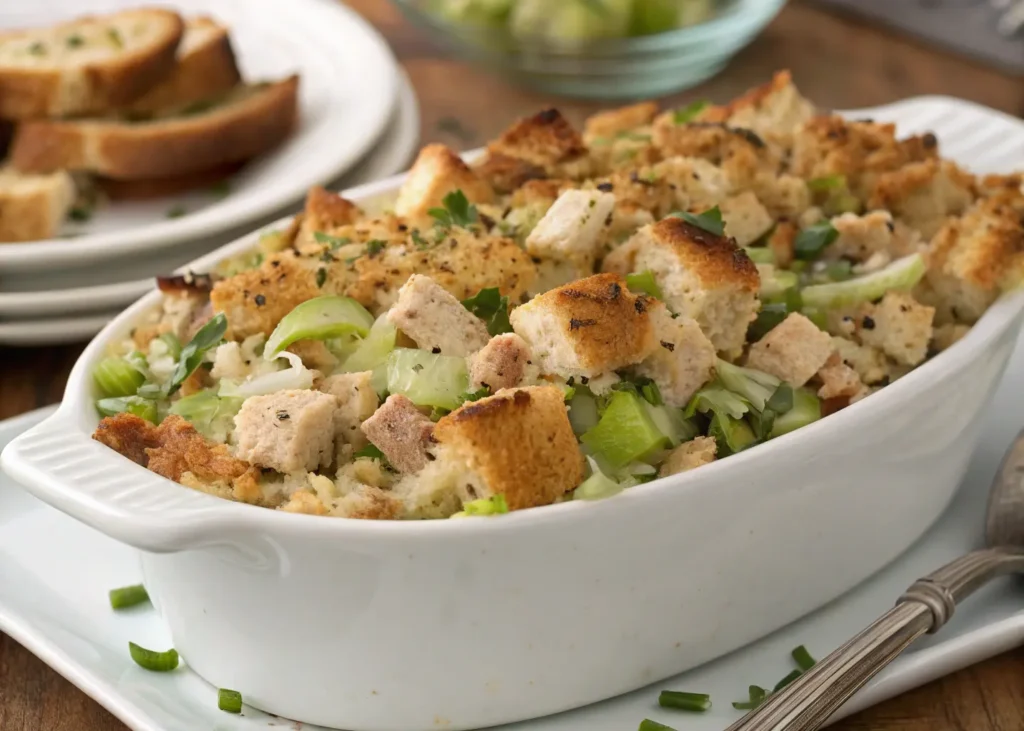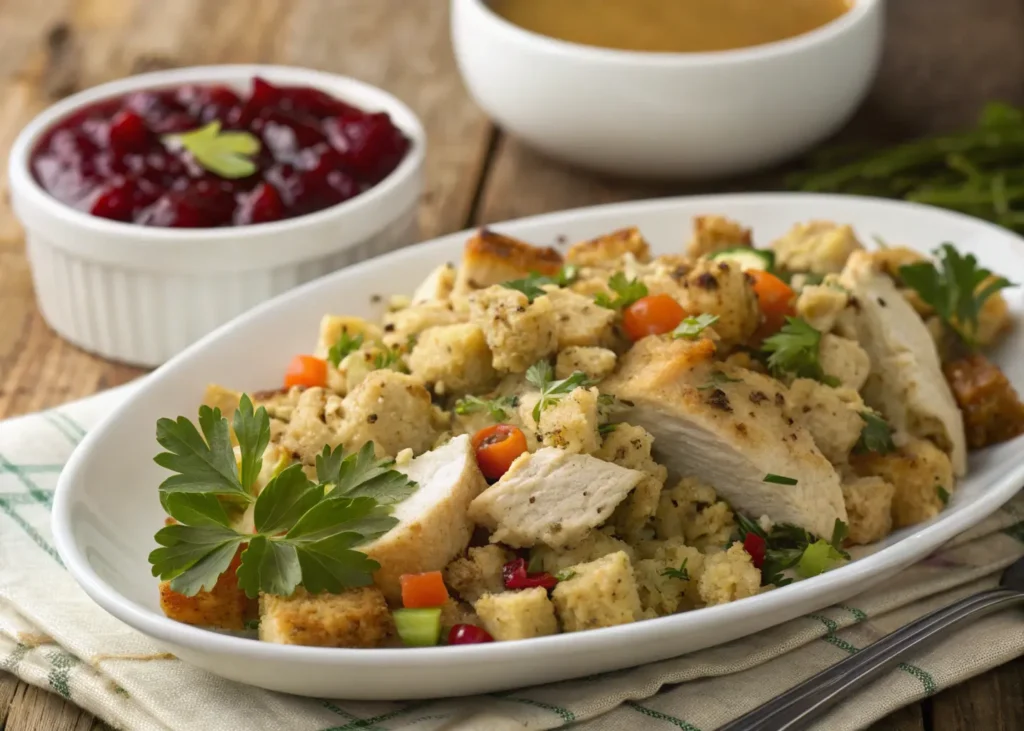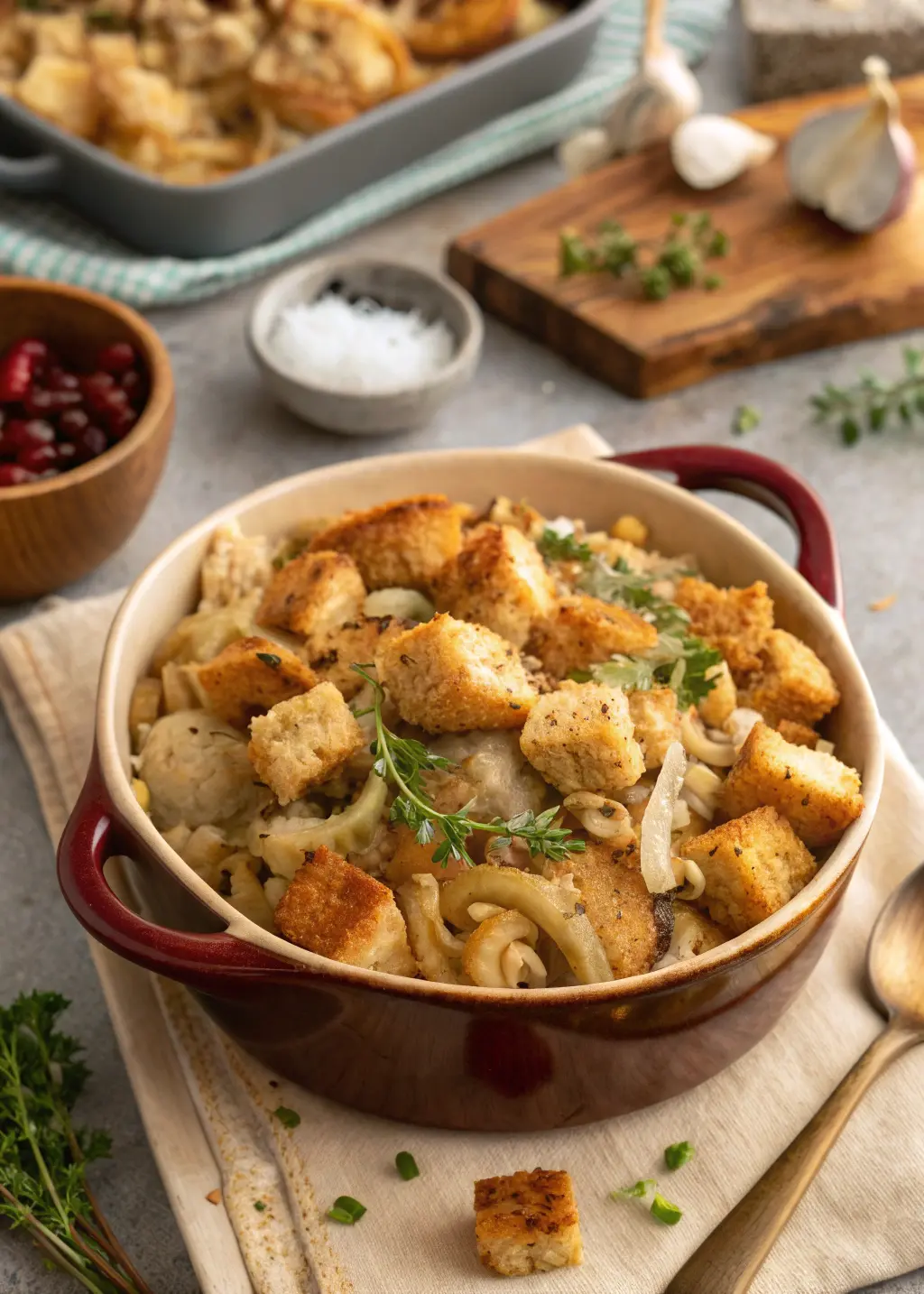Classic Chicken Dressing: 5 Simple Steps to Make It Perfect (Every Time)
Picture yourself standing in your grandmother’s kitchen, breathing in the rich aroma of herbs mingling with tender chicken and golden cornbread. That distinctive scent has the power to transport you instantly back to childhood Sunday dinners, where anticipation built around the dining table as steaming dishes appeared one by one. Perhaps you’ve been that eager observer, watching seasoned cooks work their magic while you wondered if you’d ever master such culinary artistry.
Your journey toward creating restaurant-quality classic chicken dressing ends today. This beloved comfort food, which has graced American tables for generations, becomes surprisingly manageable when broken down into five straightforward steps. Whether you’re preparing for your first holiday hosting experience or seeking to recreate those cherished family flavors, this comprehensive guide transforms kitchen intimidation into confident cooking.
Table of contents

What Makes Classic Chicken Dressing So Special?
The Heart of American Comfort Cuisine
Classic chicken dressing represents more than just another side dish—it embodies the soul of American comfort cooking. This traditional recipe emerged from resourceful home cooks who transformed simple pantry staples into memorable family centerpieces. Unlike its stuffed counterpart, dressing develops distinct textures and flavors when baked separately, allowing each ingredient to contribute its unique character to the final masterpiece.
Your success with this dish depends on understanding its fundamental appeal: the perfect balance between hearty satisfaction and nostalgic comfort. Each spoonful delivers layers of savory chicken, aromatic herbs, and tender bread that work together harmoniously rather than competing for attention.
Regional Variations and Cultural Significance
Across different American regions, classic chicken dressing takes on subtle variations that reflect local preferences and available ingredients. Southern versions often incorporate crumbled sausage and emphasize sage, while Midwestern adaptations might include wild rice or mushrooms. These regional touches demonstrate how families have personalized this foundational recipe over decades, creating unique traditions that pass from generation to generation.
Essential Ingredients for Perfect Classic Chicken Dressing
The Foundation: Quality Ingredients Matter
Your ingredient selection directly impacts the final taste and texture of your classic chicken dressing. Each component serves a specific purpose in creating the ideal balance of flavors and consistency.
| Ingredient Category | Specific Items | Quantity (Serves 8-10) | Purpose |
|---|---|---|---|
| Bread Base | Day-old cornbread | 6 cups, crumbled | Primary texture and flavor foundation |
| White bread slices | 4 slices, cubed | Additional bulk and moisture absorption | |
| Protein | Cooked chicken | 2-3 cups, shredded | Main protein component |
| Chicken broth | 3-4 cups | Moisture and flavor base | |
| Vegetables | Yellow onions | 2 medium, diced | Aromatic foundation |
| Celery stalks | 3-4 stalks, chopped | Texture and fresh flavor | |
| Fresh sage | 2 tablespoons | Traditional herb signature | |
| Binding | Large eggs | 2-3 eggs | Structural integrity |
| Butter | 4 tablespoons | Richness and moisture |
Smart Shopping and Preparation Tips
When selecting ingredients for your classic chicken dressing, prioritize freshness and quality over convenience. Day-old cornbread provides the ideal texture—fresh bread becomes too soggy, while overly stale pieces won’t absorb liquids properly. Your chicken can come from various sources: leftover roast chicken, rotisserie chicken from the grocery store, or specially poached chicken breasts.
Fresh herbs make a remarkable difference in flavor depth compared to their dried counterparts. If you must use dried sage, reduce the quantity by half and add it earlier in the cooking process to allow proper rehydration.
The 5 Simple Steps to Perfect Classic Chicken Dressing
Step 1: Prepare Your Bread Base
Begin your classic chicken dressing preparation by addressing the foundation element: your bread mixture. Crumble your day-old cornbread into irregular, bite-sized pieces—uniformity isn’t crucial here, as varied textures add visual and tactile interest to the finished dish.
Cut your white bread slices into small cubes, roughly half-inch squares. Combine both bread types in a large mixing bowl, then season lightly with salt and freshly ground black pepper. This preliminary seasoning ensures flavor penetration throughout the base layer.
Allow this mixture to sit uncovered for approximately thirty minutes if your bread seems slightly fresh. This resting period permits additional moisture evaporation, creating optimal absorption capabilities for the liquid components you’ll add later.
Step 2: Create the Aromatic Vegetable Base
Heat your butter in a large skillet over medium heat until it begins foaming gently. Add your diced onions and cook patiently until they become translucent and fragrant, approximately eight to ten minutes. Rushing this process by increasing heat will result in browned edges rather than the sweet, mellow flavor you want.
Incorporate your chopped celery and continue cooking until the pieces soften but retain slight crispness, about five additional minutes. The celery provides essential textural contrast and fresh flavor notes that balance the richness of other ingredients.
Add your fresh sage during the final minute of cooking, stirring constantly to prevent burning. Fresh herbs release their essential oils quickly when heated, so brief exposure preserves their bright flavor while eliminating any raw harshness.

Step 3: Combine Chicken and Seasonings
Remove your cooked chicken from bones and shred into bite-sized pieces using two forks or your hands. Avoid cutting with a knife, as shredded chicken integrates better with other ingredients and provides more appealing texture in the finished dressing.
Season your shredded chicken generously with salt, pepper, and additional herbs if desired. Toss the seasoned chicken with your sautéed vegetable mixture while both components remain warm. This temperature combination allows flavors to meld effectively before adding to your bread base.
Taste this mixture and adjust seasonings as needed. Remember that the bread will dilute flavors somewhat, so your chicken-vegetable combination should taste slightly more intense than your desired final result.
Step 4: Mix and Bind the Dressing
Pour your warm chicken and vegetable mixture over your prepared bread base, distributing evenly throughout. Using clean hands or a large spoon, toss gently to combine all elements without overmixing, which can create dense, heavy texture.
Beat your eggs thoroughly in a separate bowl until completely smooth, then pour over your mixture. Begin adding warm chicken broth gradually, starting with two cups and mixing gently after each addition. Your goal is achieving moistness that holds together when lightly pressed but isn’t soupy or swimming in liquid.
Allow your completed mixture to rest for ten minutes before baking. This resting period permits proper moisture absorption and helps identify whether additional liquid is necessary for optimal consistency.
Step 5: Bake to Golden Perfection
Preheat your oven to 375°F while your dressing rests. Transfer your mixture to a buttered baking dish, spreading evenly without packing too densely. Cover with aluminum foil for the initial twenty minutes of baking time.
Remove the foil and continue baking until the surface develops beautiful golden-brown color and slight crispiness around edges, approximately fifteen to twenty additional minutes. Your classic chicken dressing is finished when the internal temperature reaches 165°F and the texture feels firm but springy when gently pressed.
Allow your dressing to rest for ten minutes before serving. This final resting period permits the structure to set properly and prevents crumbling when portioned.
Pro Tips for Classic Chicken Dressing Success
Achieving Perfect Texture
Temperature control plays a crucial role in texture development. Adding hot broth to your mixture can create mushiness, while cold liquid may not distribute evenly. Warm broth integrates smoothly and promotes even moisture distribution throughout your dressing.
Your mixture should resemble wet concrete consistency before baking—cohesive enough to hold its shape but not so dry that it appears crumbly. If you’re uncertain about moisture levels, err slightly on the drier side, as you can always add more liquid but cannot easily remove excess.
Flavor Enhancement Techniques
Layer your seasonings throughout the cooking process rather than adding everything at once. Season your bread base, your chicken mixture, and taste your combined ingredients before baking. This approach ensures balanced flavor distribution rather than pockets of intense seasoning.
Consider reserving some fresh herbs for finishing. A sprinkle of fresh sage or parsley just before serving brightens the overall flavor profile and adds visual appeal to your presentation.
Troubleshooting Common Issues
Fixing Texture Problems
If your finished classic chicken dressing seems too dry, drizzle additional warm broth over individual portions rather than the entire dish. This targeted approach prevents oversaturating areas that may already have proper moisture content.
Conversely, if your dressing appears too wet after the initial baking period, remove the foil and continue baking in five-minute intervals until excess moisture evaporates and the surface firms appropriately.
Addressing Flavor Imbalances
Bland dressing typically results from under-seasoning at multiple stages rather than insufficient salt alone. Boost flavor with additional herbs, a splash of white wine, or even a small amount of chicken bouillon dissolved in warm water.
Over-salted dressing can be balanced by preparing a small additional batch without salt and combining portions until the flavor mellows to your preference.
Nutritional Benefits and Considerations
Your homemade classic chicken dressing provides substantial nutritional value compared to many traditional side dishes. Each serving delivers approximately 18 grams of high-quality protein from chicken, complex carbohydrates from bread, and essential vitamins from vegetables and herbs.
| Nutrient | Per Serving (1 cup) | % Daily Value |
|---|---|---|
| Calories | 285 | 14% |
| Protein | 18g | 36% |
| Carbohydrates | 28g | 9% |
| Fat | 12g | 18% |
| Fiber | 3g | 12% |
For healthier variations, substitute whole grain bread for white bread, use low-sodium broth, or increase vegetable proportions while reducing bread quantities.

Transform Your Kitchen Into a Comfort Food Haven
Mastering classic chicken dressing opens doors to confident holiday cooking and memorable family meals. This foolproof five-step method eliminates guesswork while preserving the authentic flavors that make this dish so beloved across generations.
Your success with this recipe depends more on patience and attention to detail than advanced culinary skills. Each step builds upon the previous one, creating layers of flavor and texture that result in restaurant-quality comfort food from your home kitchen.
Remember that cooking is both technique and intuition. While these instructions provide your foundation, don’t hesitate to adjust seasonings or add personal touches that reflect your family’s preferences. The most treasured recipes evolve through generations of loving modification.
Ready to create your own classic chicken dressing masterpiece? Gather your ingredients, set aside an afternoon for relaxed cooking, and prepare to fill your home with the irresistible aromas of perfectly seasoned comfort food. Your family will treasure both the delicious results and the memories you create together in the kitchen.
Have you given our recipe a try?
There are no reviews yet. Be the first one to write one.







